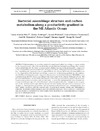Identificador persistente para citar o vincular este elemento:
https://accedacris.ulpgc.es/jspui/handle/10553/51654
| Título: | Bacterial assemblage structure and carbon metabolism along a productivity gradient in the NE Atlantic Ocean | Autores/as: | Alonso-Sáez, Laura Arístegui, Javier Pinhassi, Jarone Gómez-Consarnau, Laura González, José M. Vaqué, Dolors Agustí, Susana Gasol, Josep M. |
Palabras clave: | Bacteria Atlantic Ocean Diversity Metabolism CARD-FISH, et al. |
Fecha de publicación: | 2007 | Editor/a: | 0948-3055 | Proyectos: | COCA(REN2000 1471-CO2-O1-MAR) DEBACOCA (REN2001-4211-E) MICRODIFF (REN2001-2120/MAR) BASICS (EVK3-CT-2002-00078) GENMUMAR (CTM2004-02586/MAR) |
Publicación seriada: | Aquatic Microbial Ecology | Resumen: | Bacterioplankton have the potential to significantly affect the cycling of organic matter in the ocean; however, little is known about the linkage between bacterial assemblage structure and carbon metabolism. In this study, we investigated whether changes in the phylogenetic composition of bacterioplankton were associated with changes in bacterial carbon processing (bacterial production, respiration and biomass) in the subtropical NE Atlantic Ocean. We found consistent differences in the composition of the bacterial assemblage, as revealed by denaturing gradient gel electrophoresis (DGGE) and catalyzed reporter deposition-fluorescence in situ hybridization (CARD-FISH), along a gradient from the NW African upwelling to the oligotrophic North Atlantic Subtropical Gyre. The percent contribution of Bacteroidetes, Roseobacter and Gammaproteobacteria significantly increased towards more productive waters, whereas the SAR11 clade of the Alphaproteobacteria remained relatively constant (average 28% of DAPI-stained cells) throughout the area. Changes in the composition of the bacterial assemblage detected by DGGE were weakly but significantly correlated with changes in carbon processing variables. The abundances of Roseobacter and Gammaproteobacteria were highly correlated with the concentration of particulate organic carbon and chlorophyll a, reflecting the affinity of these groups to nutrient-enriched conditions. The abundance of Roseobacter was also positively correlated with heterotrophic bacterial production, suggesting their active participation in carbon processing. | URI: | https://accedacris.ulpgc.es/handle/10553/51654 | ISSN: | 0948-3055 | DOI: | 10.3354/ame046043 | Fuente: | Aquatic Microbial Ecology [ISSN 0948-3055], v. 46, p. 43-53 |
| Colección: | Artículos |
Citas SCOPUSTM
66
actualizado el 08-jun-2025
Citas de WEB OF SCIENCETM
Citations
66
actualizado el 08-jun-2025
Visitas
176
actualizado el 04-ene-2025
Descargas
113
actualizado el 04-ene-2025
Google ScholarTM
Verifica
Altmetric
Comparte
Exporta metadatos
Los elementos en ULPGC accedaCRIS están protegidos por derechos de autor con todos los derechos reservados, a menos que se indique lo contrario.
